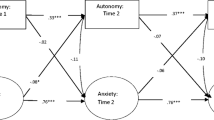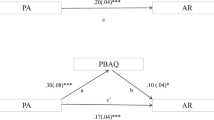Abstract
Parental overprotection and modeling of fearful behaviors have been proposed to play a central role in the development of anxiety. Yet there have been few longitudinal examinations of these relationships and virtually none focusing on the adolescent period. The current study measured adolescent perceptions of maternal anxious parenting (a combination of overprotection and expression of anxiety), mothers’ levels of anxiousness, and adolescents’ anxiety symptoms in 421 girls in grade 7 and their mothers. Measures were repeated 12 months later. When the adolescent’s self report of anxiety was used as the outcome, the adolescent’s perception of maternal anxious parenting significantly predicted adolescent anxiety 12 months later. When the mother’s report of adolescent anxiety was used as the outcome adolescent anxiety significantly predicted adolescent perceptions of maternal anxious parenting 12 months later. Maternal anxiousness predicted the adolescent’s perception of anxious parenting, but meditational relationships were not significant in either model. The data are partly consistent with reciprocal influence models of parent/child relationships but point to the importance of informant perspectives in determining relationships between these complex variables.


Similar content being viewed by others
References
Antony, M. M., Bieling, P. J., Cox, B. J., Enns, M. W., & Swinson, R. P. (1998). Psychometric properties of the 42-item and 21-item versions of the depression anxiety stress scales in clinical groups and a community sample. Psychological Assessment, 10(2), 176–181.
Armsden, G. C., McCauley, E., Greenberg, M. T., Burke, P. M., & Mitchell, J. R. (1990). Parent and peer attachment in early adolescent depression. Journal of Abnormal Child Psychology, 18, 683–697.
Baron, R. M., & Kenny, D. A. (1986). The moderator-mediator variable distinction in social psychological research: Conceptual, strategic, and statistical considerations. Journal of Personality and Social Psychology, 51(6), 1173–1182.
Bayer, J. K., Sanson, A. V., & Hemphill, S. A. (2006). Parent influences on early childhood internalizing difficulties. Journal of Applied Developmental Psychology, 27, 542–559.
Bruch, M. A., Heimberg, R. G., Berger, P., & Collins, T. M. (1989). Social phobia and perceptions of early parental and personal characteristics. Anxiety Research, 2, 57–65.
Chorpita, B. F., & Barlow, D. H. (1998). The development of anxiety: the role of control in the early environment. Psychological Bulletin, 124, 3–21.
Cole, D. A., & Maxwell, S. E. (2003). Testing mediational models with longitudinal data: questions and tips in the use of structural equation modeling. Journal of Abnormal Psychology, 112(4), 558–577.
Cole, D. A., Martin, J. M., Peeke, L., Henderson, A., & Harwell, J. (1998). Validation of depression and anxiety measures in white and black youths: multitrait-multimethod analyses. Psychological Assessment, 10(3), 261–276.
Cole, D. A., Hoffman, K., Tram, J., & Maxwell, S. E. (2000). Structural differences in parent and child reports of children’s symptoms of depression and anxiety. Psychological Assessment, 12, 174–195.
Coplan, R. J., Arbeau, K. A., & Armer, M. (2008). Don’t fret, be supportive! Maternal characteristics linking child shyness to psychosocial and school adjustment in kindergarten. Journal of Abnormal Child Psychology, 36(3), 359–371.
de Rosnay, M., Cooper, P. J., Tsigaras, N., & Murray, L. (2006). Transmission of social anxiety from mother to infant: an experimental study using a social referencing paradigm. Behaviour Research and Therapy, 44(8), 1165–1175.
Edwards, S. L., Rapee, R. M., & Kennedy, S. (in press). Prediction of anxiety symptoms in preschool-aged children: Examination of maternal and paternal perspectives. Journal of Child Psychology and Psychiatry.
Epkins, C., & Meyers, A. (1994). Assessment of childhood depression, anxiety and aggression: Convergent and discriminant validity of self-, parent-, teacher-, and peer-report measures. Journal of Personality Assessment, 62, 364–381.
Field, A. P. (2006). Is conditioning a useful framework for understanding the development and treatment of phobias? Clinical Psychology Review, 26(7), 857–875.
Furman, W., & Buhrmester, D. (1992). Age and sex differences in perceptions of networks of personal relationships. Child Development, 63, 103–115.
Garber, J. (2005). Depression and the family. In J. L. Hudson & R. M. Rapee (Eds.), Psychopathology and the family (pp. 225–280). Oxford: Elsevier.
Gerull, F. C., & Rapee, R. M. (2002). Mother knows best: effects of maternal modelling on the acquisition of fear and avoidance behaviour in toddlers. Behaviour Research and Therapy, 40, 279–287.
Grills, A. E., & Ollendick, T. H. (2003). Multiple informant agreement and the anxiety disorders interview schedule for parents and children. Journal of the American Academy of Child and Adolescent Psychiatry, 42(1), 30–40.
Gruner, K., Muris, P., & Merckelbach, H. (1999). The relationship between anxious rearing behaviors and anxiety disorders symptomatology in normal children. Journal of Behavior Therapy and Experimental Psychiatry, 30(1), 27–35.
Holmbeck, G. N. (1997). Toward terminological, conceptual, and statistical clarity in the study of mediators and moderators: examples from the child-clinical and pediatric psychology literatures. Journal of Consulting and Clinical Psychology, 65(4), 599–610.
Hu, L.-T., & Bentler, P. M. (1999). Cutoff criteria for fit indexes on covariance structure analysis: Conventional criteria versus new alternatives. Structural Equation Modeling, 6(1), 1–55.
Hudson, J. L., & Rapee, R. M. (2004). From anxious temperament to disorder: An etiological model of generalized anxiety disorder. In R. G. Heimberg, C. L. Turk & D. S. Mennin (Eds.), Generalized anxiety disorder: Advances in research and practice (pp. 51–76). New York: Guilford.
Lieb, R., Wittchen, H.-U., Hofler, M., Fuetsch, M., Stein, M. B., & Merikangas, K. R. (2000). Parental psychopathology, parenting styles, and the risk of social phobia in offspring: a prospective-longitudinal community study. Archives of General Psychiatry, 57(9), 859–866.
Lovibond, S. H., & Lovibond, P. F. (1995). The structure of negative emotional states: comparison of the depression anxiety stress scales (DASS) with the Beck Depression and Anxiety Inventories. Behaviour Research and Therapy, 33, 335–344.
Manassis, K., & Bradley, S. J. (1994). The development of childhood anxiety disorders: toward an integrated model. Journal of Applied Developmental Psychology, 15, 345–366.
McLeod, B. D., Wood, J. J., & Weisz, J. R. (2007). Examining the association between parenting and childhood anxiety: a meta-analysis. Clinical Psychology Review, 27, 155–172.
Mills, R. S. L., & Rubin, K. H. (1990). Parental beliefs about problematic social behaviors in early childhood. Child Development, 61, 138–151.
Mineka, S., & Zinbarg, R. (2006). A contemporary learning theory perspective on the etiology of anxiety disorders: it’s not what you thought it was. American Psychologist, 61(1), 10–26.
Muris, P., Steerneman, P., Merckelbach, H., & Meesters, C. (1996). The role of parental fearfulness and modelling in children’s fear. Behaviour Research and Therapy, 34(3), 265–268.
Murray, L., de Rosnay, M., Pearson, J., Sack, C., Schofield, E., Royal-Lawson, M. et al. (2008). Intergenerational transmission of social anxiety: the role of social referencing processes in infancy. Child Development, 79(4), 1049–1064.
Najman, J. M., Williams, G. M., Nickles, J., Spence, S. H., Bor, W., O’Callaghan, M., et al. (2001). Bias influencing maternal reports of child behavior and emotional state. Social Psychiatry and Psychiatric Epidemiology, 36, 186–194.
Nasser, F., & Wisenbaker, J. (2003). A Monte Carlo study investigating the impact of item parceling on measures of fit in confirmatory factor analysis. Educational and Psychological Measurement, 63(5), 729–757.
Nauta, M. H., Scholing, A., Rapee, R. M., Abbott, M., & Spence, S. H. (2004). Development of a parent report measure of children’s anxiety: psychometric properties and comparison with child report in a clinic and normal sample. Behaviour Research and Therapy, 42, 813–839.
Oh, K. J., Shin, Y. J., Moon, K. J., Hudson, J. L., & Rapee, R. M. (2002). Childrearing practices and psychological disorders in children: cross cultural comparisons of Korea and Australia. Yonsei Medical Journal, 43, 411–419.
Parker, G. (1983). Parental overprotection: a risk factor in psychosocial development. Sydney: Grune & Stratton.
Phares, V., Compas, B. E., & Howell, D. (1989). Perspectives on child behavior problems: comparisons of children’s self-reports with parent and teacher reports. Psychological Assessment, 1, 68–71.
Rapee, R. M. (1997). Potential role of childrearing practices in the development of anxiety and depression. Clinical Psychology Review, 17, 47–67.
Rapee, R. M. (2008). Prevention of mental disorders: promises, limitations, and barriers. Cognitive and Behavioral Practice, 15, 47–52.
Rapee, R. M., & Melville, L. F. (1997). Recall of family factors in social phobia and panic disorder: comparison of mother and offspring reports. Depression and Anxiety, 5, 7–11.
Rapee, R. M., & Spence, S. H. (2004). The etiology of social phobia: empirical evidence and an initial model. Clinical Psychology Review, 24, 737–767.
Rapee, R. M., Schniering, C. A., & Hudson, J. L. (2009). Anxiety disorders during childhood and adolescence: origins and treatment. Annual Review of Clinical Psychology, 5, 311–341.
Rubin, K. H., & Mills, R. S. L. (1991). Conceptualizing developmental pathways to internalizing disorders in childhood. Canadian Journal of Behavioural Science, 23, 300–317.
Rubin, K. H., Nelson, L. J., Hastings, P., & Asendorpf, J. (1999). The transaction between parents’ perceptions of their children’s shyness and their parenting styles. International Journal of Behavioral Development, 23(4), 937–957.
Rubin, K. H., Burgess, K. B., & Hastings, P. D. (2002). Stability and social-behavioral consequences of toddlers’ inhibited temperament and parenting behaviors. Child Development, 73(2), 483–495.
Rubin, K. H., Coplan, R. J., & Bowker, J. C. (2009). Social withdrawal in childhood. Annual Review of Psychology, 60, 11.11–11.31.
Sacco, W., & Graves, D. (1985). Correspondence between teacher ratings of childhood depression and child self-ratings. Journal of Clinical Child Psychology, 14, 353–355.
Spence, S. H. (1998). A measure of anxiety symptoms among children. Behaviour Research and Therapy, 36(5), 545–566.
Whaley, S. E., Pinto, A., & Sigman, M. (1999). Characterizing interactions between anxious mothers and their children. Journal of Consulting and Clinical Psychology, 67, 826–836.
Wood, J. J., McLeod, B. D., Sigman, M., Hwang, W., & Chu, B. C. (2003). Parenting and childhood anxiety: theory, empirical findings, and future directions. Journal of Child Psychology and Psychiatry, 44(1), 134–151.
Acknowledgements
The author would like to express his gratitude to Jordana McLoone and Joel Roast for their tireless and dedicated efforts in collecting the data for this study as well as data coding and entry. Thanks also to Jennifer Mitchell for help with data coding. The research was supported by grant # DP0210155 from the Australian Research Council.
Author information
Authors and Affiliations
Corresponding author
Rights and permissions
About this article
Cite this article
Rapee, R.M. Early Adolescents’ Perceptions of Their Mother’s Anxious Parenting as a Predictor of Anxiety Symptoms 12 Months Later. J Abnorm Child Psychol 37, 1103–1112 (2009). https://doi.org/10.1007/s10802-009-9340-2
Published:
Issue Date:
DOI: https://doi.org/10.1007/s10802-009-9340-2




